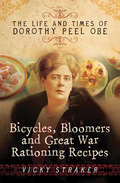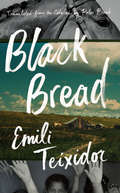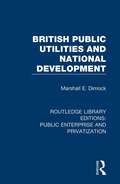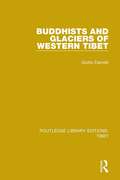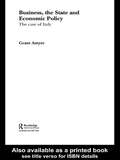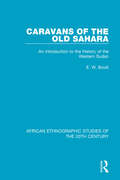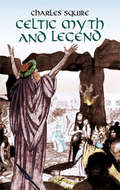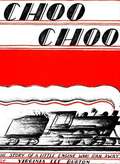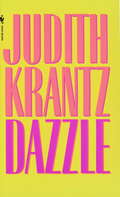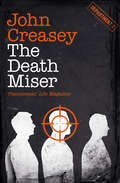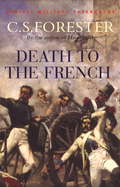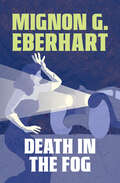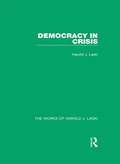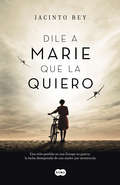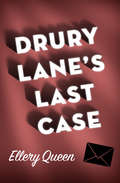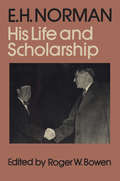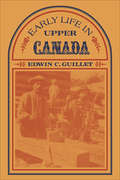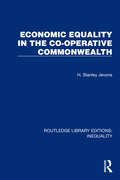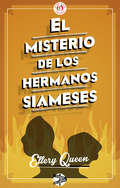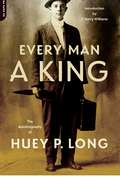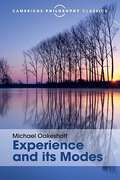- Table View
- List View
Bicycles, Bloomers and Great War Rationing Recipes: The Life And Times Of Dorothy Peel Obe
by Victoria StrakerDorothy Peel was the Nigella Lawson or Delia Smith of her day during the late Victorian to post-war period. In this book, Vicky Straker explores the social history and cultural background behind Dorothy's creations, and the effect of rationing during the First World War. Dorothy played a key role in creating wartime recipes for householders and was awarded an OBE in 1918 for services to the Ministry of Food. Using extracts from her autobiography, and many other books, we are given a unique insight into the life of Dorothy Peel and a new perspective on the period. Her witty, poignant and informative comments reveal a woman with a genuine social conscience, who was in many ways ahead of her time. Written in a light and accessible style, the 10 chapters cover aspects of the era revealing how society changed during the First World War, and when rationing put a strain on every kitchen in the country. Many of Dorothy's recipes are featured in their original form, such as the long forgotten Devilled Bananas, and wartime Potato Gateau. Other mouth-watering recipes include Chicken en Casserole, Cheese Pufflets, and some delicious tea-time treats such as Feather Tart and Candied Pears. Vicky Straker has tried and tested recipes from Dorothy's cookery books, and where appropriate amended them to suit modern tastes.
Black Bread
by Peter Bush Emili TeixidorIn the rough hill country of rural Catalonia, the Spanish Civil War is over and the villagers live under occupation by the fascist Civil Guard. With his father in jail, facing possible execution as a subversive, and his mother working long hours in a factory, eleven-year-old Andreu is sent to live with his grandmother, uncles, aunts and cousins in a farmhouse in a remote valley. His inquisitive, self-taught grandmother encourages him to study, but who will Andreu become? He doesn't want to be a farmhand, or work in a factory, or flee into exile in France like his uncle and aunt. His cousin Núria invites him to play sex games with her in the woods, but Andreu cannot stop thinking about a young man he sees lying naked in a monastery garden.Confronted on all sides by the need to define himself, Andreu must make a difficult decision. One of the major novels of contemporary Spain, and the inspiration for the first film in the Catalan language to be nominated by Spain for an Academy Award, Black Bread brings to life a rural world of mythical force as it traces with piercing psychological insight, in gorgeous prose, the movements of a boy's psyche as he contemplates growing into an adult.Born in 1933, Emili Teixidor's first novel, Retrato de un asesino de pájaros, was published to tremendous acclaim in 1988, followed by several more which established him as one of Spain's greatest contemporary authors. Teixidor died in 2012.
British Public Utilities and National Development (Routledge Library Editions: Public Enterprise and Privatization)
by Marshall E. DimockOne of the most important trends in post-war Britain was the extension of the number and variety of public service undertakings. Originally published in 1933, this title indicated the empirical nature and recent importance of British public utility development at the time, being the first study, which dealt with this trend in a comprehensive manner. For completeness to the book and also providing a suitable background, the local utility services water, gas, transport, docks, and harbors have been considered. The author felt the trends of recent years made a rediscovery of political economy imperative and urgent. This study was an effort to reunite economics, public administration, law, and philosophy in the consideration of British public utilities.
Buddhists and Glaciers of Western Tibet (Routledge Library Editions: Tibet #3)
by Giotto DainelliThis book, first published in 1933, reproduces the diary of the 1930 explorations by the great Italian traveller, Giotto Dainelli. In it he records his experiences as he travels the little-explored (by Westerners) region of Western Tibet, and the result is a detailed snapshot of Tibetan life, cultures and customs of the time.
Buenaventura
by Toni AparicioUna tragedia familiar la condujo a la mansión de los Campoamor; una misteriosa desaparición le devolvió la libertad. Un secreto familiar silenciado...Santamaría de la Villa, 1933. La vida de Esperanza cambiará para siempre. Se dirige hacia la mansión de los Campoamor, una de las familias aristócratas más respetadas de Asturias. Lleva consigo una maleta, el peso de los recuerdos y un extraño presentimiento. Está allí porque ha sido contratada como dama de compañía de la señora, pero se da cuenta enseguida de que no es bien recibida... Una misteriosas desaparición...El paso de los días acrecienta esa sensación y aumenta el desasosiego. Esperanza está convencida de que hay algo más, y las horas se vuelven insoportables. Descubre que hay un secreto que todo el personal guarda y que está relacionado con Buenaventura, hija y única heredera de doña Rosario, que al parecer ha desaparecido en circunstancias extrañas. Y una lucha desesperada contra el destino...Sabe que ni don Manuel, el médico, ni Diego Carreño, el administrador de la finca, ni la señorita Agustina, la férrea ama de llaves, se lo pondrán fácil, pero está decidida a descubrir la verdad. En ese camino chocará con los fantasmas de su pasado y descubrirá el precio de una vida nueva. Narrada con un estilo envolvente que recuerda a Rebeca, Jane Eyre o El jardín olvidado, Toni Aparicio construye con maestría una novela magnética que cautiva y golpea, que descubre las aristas de los secretos y sus peligros y que retrata la violencia de unos seres que luchan por hacerse hueco. Una novela de ambientes, de estilo gótico, de miradas y silencios. Un misterio familiar que nos traslada al mundo rural gobernado por los instintos primarios donde la pureza y los sueños luchan por abrirse camino. «Todavía eres joven para ser consciente de lo que te digo y es normal. Cuando una es joven, cree que tienetodo el tiempo del mundo y, en cierta manera, así es. Pero el tiempo se acaba. No emplearlo debidamente es un grandísimo error que no nos podemos permitir». «Todos sabíamos que Buenaventura era especial. Sin duda el haber nacido en una familia rica la situaba en una posición privilegiada, pero ella no quería ser solo una mujer apoltronada en su condición. Quería vivir, saber, viajar, conocer, amar...».
Buenaventura
by Toni AparicioUna tragedia familiar la condujo a la mansión de los Campoamor; una misteriosa desaparición le devolvió la libertad. Un secreto familiar silenciado...Santamaría de la Villa, 1933. La vida de Esperanza está a punto de cambiar para siempre. Se dirige hacia la mansión de los Campoamor, una de las familias aristócratas más respetadas de Asturias. Lleva consigo una maleta, el peso de los recuerdos y un extraño presentimiento. Está allí porque ha sido contratada como dama de compañía de la señora, pero se da cuenta enseguida de que no es bien recibida... Una misteriosas desaparición...El paso de los días acrecienta esa sensación y aumenta el desasosiego. Esperanza está convencida de que hay algo más, y las horas se vuelven insoportables. Descubre que hay un secreto que todo el personal guarda y que está relacionado con Buenaventura, hija y única heredera de doña Rosario, que al parecer ha desaparecido en circunstancias extrañas. Y una lucha desesperada contra el destino...Sabe que ni don Manuel, el médico, ni Diego Carreño, el administrador de la finca, ni la señorita Agustina, la férrea ama de llaves, se lo pondrán fácil, pero está decidida a descubrir la verdad. En ese camino chocará con los fantasmas de su pasado y descubrirá el precio de una vida nueva. Narrada con un estilo envolvente que recuerda a Rebeca, Jane Eyre o El jardín olvidado, Toni Aparicio construye con maestría una novela magnética que cautiva y golpea, que descubre las aristas de los secretos y sus peligros y que retrata la violencia de unos seres que luchan por hacerse hueco. Una novela de ambientes, de estilo gótico, de miradas y silencios. Un misterio familiar que nos traslada al mundo rural gobernado por los instintos primarios donde la pureza y los sueños luchan por abrirse camino. «Todavía eres joven para ser consciente de lo que te digo y es normal. Cuando una es joven,cree que tiene todo el tiempo del mundo y, en cierta manera, así es. Pero el tiempo se acaba. No emplearlo debidamente es un grandísimo error que no nos podemos permitir». «Todos sabíamos que Buenaventura era especial. Sin duda el haber nacido en una familia rica la situaba en una posición privilegiada, pero ella no quería ser solo una mujer apoltronada en su condición. Quería vivir, saber, viajar, conocer, amar...».
Business, The State and Economic Policy: The Case of Italy (Routledge Advances In European Politics Ser. #Vol. 16)
by G Grant AmyotThe framework sketched in this new book explains the relationship between state and capital in Italy as well as some of the major directions in macroeconomic theory. These fields encompass both Italy's entry to EMU in 1999 and the impact of Silvio Berlusconi on Italian politics and economics.
Caravans of the Old Sahara: An Introduction to the History of the Western Sudan
by E. W. BovillSince publication in 1957 the importance of Bohannan's study of judicial institutions and procedures among the Tiv has been widely recognized. It has contributed widely to the continuing discussion concerning the objectives and methods to be followed in the anthropological study of law and the contribution this makes to comparative jurisprudence. the work describes and defines Tiv ideas of 'law' as expressed in the operations of their courts known as Jir. The analysis is based on and illustrated by numerous cases which the author attended and discussed with leaders in the Jir.
Celtic Myth and Legend
by Charles SquireThe legends of ancient Britain retain a profound allure for readers around the world, assuring a warm reception for this introduction to the colorful pageant of Celtic myth. Its wondrous tales range from the oft-told deeds of Arthur and the Knights of the Round Table to the less-familiar adventures of the mighty Finn and his Fenians, Ulster's Champions of the Red Branch, and other figures from the Gaelic pantheon. Tracing the exploits of kings and saints back to their earliest origins, the author reveals the pagan roots beneath the medieval Christianity and follows the stories' transformations into the fairy tales of the Victorian age. Minimal use of scholarly notes and a highly accessible style make this reader-friendly volume an ideal steppingstone in the path toward the magic cauldron of Celtic myth.
Choo Choo
by Virginia Lee BurtonThe adventures of a beautiful little locomotive who decided to run away from her humdrum duties.
Commonsense Psychology and the Home (Psychology Revivals)
by Frederick H. DoddFirst published in 1933, Commonsense Psychology and the Home was a book for parents and others who were interested in the welfare of the child and who, although sceptical of, and confused by, the conflicting schools of modern psychology at the time, desired guidance from modern knowledge combined with experience which they could appreciate as appealing to their common sense. It deals with the ideals of home life, from the choice of the partner to make a home, through the whole development of the family, ending up on the arrival of grandchildren. It shows the commonsense application of psychological principles to the happy and harmonious development of the home and the ultimate achievement of a freed personality when the child goes out into the world. It shows, step by step, how major difficulties may be avoided and minor difficulties handled.This book is a re-issue originally published in 1933. The language used and views portrayed are a reflection of its era and no offence is meant by the Publishers to any reader by this re-publication.
Dazzle: A Novel
by Judith Krantz"Captivating. Krantz's latest tome... is her most erotic yet. Dazzle sizzles." -- Daily News, Los Angeles. Now, Judith Krantz, best-selling author of Scruples, Mistral's Daughter, and Till We Meet Again, invites you into the luscious, monied world of Jazz Kilkullen, her most daring, provocative, impetuous heroine yet. "Deliciously sexy." --Cosmopolitan. Inside the fun-filled photographers' studio in California known as Dazzle, Jazz Kilkullen reigns supreme. At twenty-nine, this playful, gifted, and thoroughly sexy woman has become one of the most successful celebrity portrait photo in the world."Enjoyable... Jazz is one of the most likable free souls to emerge from the novel industry." -- The Pittsburgh Press. But her charmed career and her dashing private life, which includes three fascinating-and fascinated-men, are rocked when an unexpected tragedy leaves jazz to battle her father's vengeful ex-wife and the machinations of her half-sisters. At stake is the Kilkullen family ranch, a three-billion-dollar paradise of unspoiled California land that developers all over the world would do anything to possess... and Jazz will do anything to protect. Absolutely anything. "Judith Krantz's best novel since Scruples." -- Associated Press."Steamy." --Los Angeles Times."Hot... bubbling with sex, intrigue, and-most of all-money. Krantz is at the height of her form here." -- BooklistFrom the Paperback edition.
Death Miser (Department Z #1)
by John CreaseyThe first in the series featuring British intelligence’s elite detectives by the Edgar Award–winning author. Millions of lives are at stake if a sinister international conspiracy succeeds. It’s up to England’s elite detective agency, Department Z, to make sure that doesn’t happen. They’ve got to keep things quiet, too. Discretion is something the Hon. James Quinion knows only too well—it’s all part and parcel of being a member of the secret service. Now, as Department Z’s agents prepare for this high-profile, high-risk assignment, Quinion will find himself right in the line of fire—and in personal danger . . .
Death To The French
by C. S. ForesterA stand-alone novel that inspired Bernard Cornwell's Sharpe seriesIt is 1810, and the last French invasion of Portugal has penned Wellington's army behind the river Tagus with their backs to the sea.Separated from his regiment, Rifleman Dodd of the Ninety-Fifth stumbles on a band of undisciplined Portuguese guerrillas. With rough inventiveness he transforms this ramshackle group into an organised fighting force, continually harrying the infuriated enemy as he battles his way back to his own lines.Written by the author of the Hornblower series, DEATH TO THE FRENCH is a classic novel of the Peninsular War, and was the inspiration for Bernard Cornwell's Sharpe books.
Death To The French
by C. S. ForesterA stand-alone novel that inspired Bernard Cornwell's Sharpe seriesIt is 1810, and the last French invasion of Portugal has penned Wellington's army behind the river Tagus with their backs to the sea.Separated from his regiment, Rifleman Dodd of the Ninety-Fifth stumbles on a band of undisciplined Portuguese guerrillas. With rough inventiveness he transforms this ramshackle group into an organised fighting force, continually harrying the infuriated enemy as he battles his way back to his own lines.Written by the author of the Hornblower series, DEATH TO THE FRENCH is a classic novel of the Peninsular War, and was the inspiration for Bernard Cornwell's Sharpe books.
Death in the Fog
by Mignon G. EberhartThis classic mystery is “more than a mere crime puzzle. . . . It is a tragic event which deeply affects the destinies of those who are in any way involved” (The New York Times).The road to her aunt’s country house on Lake Michigan is dark and shrouded in fog. But it’s a road Katie Warren knows well, having taken up residence with her Aunt Mina after losing her job during the stock market crash. But as she enters the gates to the gloomy mansion, a figure appears in the murky darkness—and Katie drives right into it, resulting in the death of her ailing aunt’s longtime companion, Charlotte Weinberg. The police are called in to investigate and when it becomes clear there was no love lost between Katie and Charlotte, Katie falls under suspicion. But Katie has her own suspicions when she discovers the death in the fog was no accident at all. Now sharing her aunt’s house with a list of suspects, Katie must rely on her wits to find a murderer—before the murderer gets her first.Praise for Mignon Eberhart“Eberhart is one of the great ladies of twentieth-century mystery fiction.” —John Jakes, author of the North and South Trilogy“One of America’s favorite writers.” —Mary Higgins Clark
Democracy in Crisis (The Works of Harold J. Laski)
by Harold J. LaskiThis volume is an expanded version of the Weil lectures given at the University of North Carolina in 1931 and is one of the two texts of Laski’s quasi Marxist period.
Dile a Marie que la quiero
by Jacinto ReyUna niña perdida en una Europa en guerra, y la lucha desesperada de una madre por encontrarla. Una conmovedora historia de la Segunda Guerra Mundial «Entonces reparó en Mathilde [...]. Le bastó una ojeada para saber que no podría hacer nada por ella. Mathilde movió un brazo con dificultad, sacó una fotografía del bolsillo y susurró: -Dile a Marie que la quiero. Paul acarició sus cabellos, guardó el retrato de la niña y besó el rostro de Mathilde. A partir de ese momento, nada volvería a ser como antes.» Jacinto Rey hilvana una novela que muestra un tapiz de historias protagonizadas por seres humanos golpeados por una guerra que los pone al límite. Acción y emoción se dan la mano para dar sentido a unas palabras que son el motor de una búsqueda, de una posible salida al horror. Dile a Marie que la quiero es una novela magistral, muy bien documentada, que recrea una época convulsa, llena de luces y sombras, para encender la llama de la esperanza en medio de la oscuridad. La mirada y el estilo de Jacinto Rey y su habilidad para construir tramas que nos transportan en un viaje laberíntico a momentos críticos de la historia, especialmente duros, no han pasado desapercibidos por los editores internacionales que ven en Rey atisbos del mejor Ken Follett, Tatiana de Rosnay o Marcus Zusak.
Drury Lane's Last Case (Drury Lane Mysteries #4)
by Ellery QueenWith the help of actor Drury Lane, Inspector Thumm chases a stolen manuscript and a man with a rainbow beard Inspector Thumm has never seen such a marvelous beard. It is massive and pointed, a rainbow composed of all the colors of Joseph’s biblical coat. He’s so distracted by the beard that he hardly notices the man it belongs to: a prospective client with mysterious business. This bearded fellow hands over an envelope containing a million-dollar secret—and the key to a matter of life and death. However, Thumm quickly forgets his strange visitor when a rare Shakespearean manuscript is stolen, only to be replaced by a rarer, more valuable one. With the help of the legendary Shakespearean actor Drury Lane, Thumm must locate the missing manuscript and solve an impossible murder—before the curtain comes down forever.
E.H. Norman: His Life and Scholarship
by Roger W. BowenThe ashes of Herbert Norman now lie in the British cemetery at Rome, near those of Shelley and Keats. His distinguished life and tragic death, in April 1957, are recalled and examined in this book by scholars and diplomats from four countries--the United States, Japan, Canada, and Britain.Born in rural Japan the son of a Canadian missionary, Herbert Norman studied at the University of Toronto and went in 1933 to Cambridge University on a scholarship. There, in that intellectual hothouse where it seemed one had to choose politically between communism and fascism as the future of the West, he joined the Communist party--a move that became a crime later in the fixed and 'sightless' (as the editor describes them) eyes of his American accusers.According to Edwin Reischauer, later the US ambassador to Japan, 'his harassment by the American government was unforgiveable.' His suicide in Cairo, while Canadian ambassador to Nasser's Egypt during and after the delicate times of the Suez Crisis and the establishment of the UN peace-keeping force, raised broader questions for Lester Pearson--'the right, to say nothing of the propriety, of a foreign government to intervene' in Canadian affairs.Norman was also a renowned historian of Japan. His Japan's Emergence as a Modern State has been called a classic, and between 1946 and 1950, as head of the Canadian Liaison Mission in Tokyo, he was a close and friendly adviser to General Douglas MacArthur in his efforts to reconstitute that country. Both this work and his writings on Japan were sympathetic to human freedoms and democracy, and they too became controversial as sides congealed in the Cold War. Five papers in this book assess Norman's scholarly work in the historiography of Japan.Four lecture papers by Norman (three previously unpublished) are included which show his change from 'a doctrinaire Marxist to a Jeffersonian Liberal,' a change historians can accept as fact whereas intelligence agencies could not and remade Norman into a communist. He was not a spy, the editor concludes, and should be remembered as the hero of a modern tragedy.
Early Life in Upper Canada
by Edwin GuilletAlthough there were abundant hardships, early life in Upper Canada was romantic and colourful in many ways. However, despite important contributions to the social and economic history of Canada, few good, comprehensive accounts have been generally available. Early Life in Upper Canada, originally published in 1933, is by far the finest history yet compiled, and it is now being reprinted in order to make available to a new generation an important and engrossing description of this area of Canadian history. The author, a distinguished Canadian historian, has drawn on contemporary letters, diaries, newspapers, and periodicals, as well as consulting all the existing histories, and he has supplemented these researches with interviews with persons who had personal contacts with early life in the Province. Mr. Guillet has compiled a thorough, accurate and delightfully readable history, that brings vividly to life the early settlers and their experiences. This is in accordance with the author's profound desire to make the study of Canadian history a delight rather than a chore. He has not concealed the unpleasant aspects of pioneer life, nor does he attempt to glamorize its difficulties. There is a tendency at times to forget that the founders of Upper Canada include hundreds of thousands of men and women of many nationalities, and fur traders, lumbermen, and voyageurs, as well as settlers. Their contributions, too, are acknowledged and recorded here. This book is profusely illustrated, with drawings made, in many cases, by army cartographers, who were skilled creative artists as well. Their paintings, fortunately, have been better preserved than were written accounts of the times, and are accurate depictions of pioneer life. The extensive bibliography and carefully prepared index will make this work invaluable for historians as well as for general readers.
Economic Equality in the Co-Operative Commonwealth (Routledge Library Editions: Inequality #5)
by H. Stanley JevonsOriginally published in 1933 in the midst of the Great Depression, this book discussed the possibility of a new and orderly economic system to realize social justice. The author argued that nothing but the complete equality of reward could ensure a stable order. Although utopian in its outlook, the book addressed many of the concerns of the (then) existing order. The book explains the origin of differences between different people, give a brief account of the economic theory of the capitalist system and investigates the economics of the growing demand for social and economic equality. It then discusses in more detail the most efficient economic organization to provide and safeguard the welfare of the population on the basis of equality, followed by a discussion of the economic principles involved in price-fixing and foreign trade.
El misterio de los hermanos siameses
by Ellery Queen Miguel Giménez SalesDurante un viaje en coche, Ellery Queen y su padre se topan con un increíble incendio que les obliga a desviarse de su camino. Ambos encuentran refugio en una mansión propiedad del misterioso doctor John Xavier, un cirujano que experimenta con animales. La gente que habita la propiedad, testigo de los experimentos del cirujano, no podría ser más variopinta: dos hermanos siameses que esperan una operación para separarles, un cleptómano que compulsivamente se apropia de cuantas joyas están a su alcance y Marie Carreau, dama de alto copete. Cuando el cadáver de John Xavier aparece con la mitad de una jota de diamantes en la mano, los Queen saben que tendrán que resolver un complejo misterio antes de que la mansión caiga en las fauces del fuego.
Every Man A King: The Autobiography Of Huey P. Long
by Huey P. LongHuey Long (1893-1935) was one of the most extraordinary American politicians, simultaneously cursed as a dictator and applauded as a benefactor of the masses. A product of the poor north Louisiana hills, he was elected governor of Louisiana in 1928, and proceeded to subjugate the powerful state political hierarchy after narrowly defeating an impeachment attempt. The only Southern popular leader who truly delivered on his promises, he increased the miles of paved roads and number of bridges in Louisiana tenfold and established free night schools and state hospitals, meeting the huge costs by taxing corporations and issuing bonds. Soon Long had become the absolute ruler of the state, in the process lifting Louisiana from near feudalism into the modern world almost overnight, and inspiring poor whites of the South to a vision of a better life. As Louisiana Senator and one of Roosevelt's most vociferous critics, "The Kingfish," as he called himself, gained a nationwide following, forcing Roosevelt to turn his New Deal significantly to the left. But before he could progress farther, he was assassinated in Baton Rouge in 1935. Long's ultimate ambition, of course, was the presidency, and it was doubtless with this goal in mind that he wrote this spirited and fascinating account of his life, an autobiography every bit as daring and controversial as was The Kingfish himself.
Experience and its Modes
by Michael OakeshottWhen it first appeared in 1933, Experience and its Modes was not considered a classic. But as philosophical fashion moved away from the analytic philosophy of the 1930s, this work began to seem ahead of its time. Arguing that experience is 'modal', in the sense that we always have a theoretical or practical perspective on the world, Michael Oakeshott explores the nature of philosophical experience and its relationship to three of the most important 'modes' of non-philosophical experience - science, history and practice - seeking to establish the autonomy and superiority of philosophy. In recognition of its enduring importance, this book is presented in a fresh series livery for a new generation of readers, featuring a specially commissioned preface written by Paul Franco.
